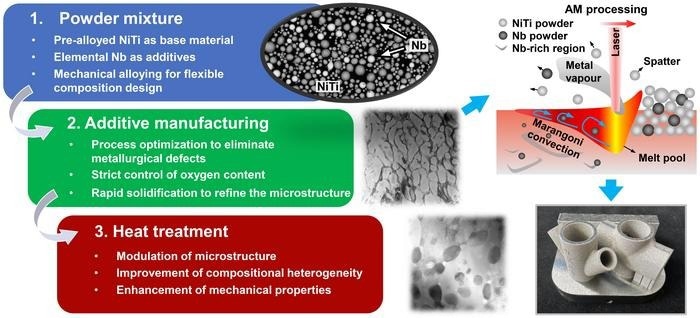Researchers from Shandong University have suggested an alloy design approach to create NiTiNb shape memory alloys (SMAs) by laser powder bed fusion in-situ alloying and post-heat treatment in a study published in the International Journal of Extreme Manufacturing.
 The figure illustrates an alloy design route in additive manufacturing of NiTiNb shape memory alloys, including three steps: (i) Mechanical mixing of pre-alloyed NiTi and elemental Nb powders as feedstocks; (ii) Laser powder bed fusion additive manufacturing to prepare detect-free parts; (iii) Solution treatment to optimize the microstructure and improve the mechanical/functional performances. Image Credit: Rui Xi, Hao Jiang, Guichuan Li, Zhihui Zhang, Huiliang Wei, Guoqun Zhao, Jan Van Humbeeck and Xiebin Wang.
The figure illustrates an alloy design route in additive manufacturing of NiTiNb shape memory alloys, including three steps: (i) Mechanical mixing of pre-alloyed NiTi and elemental Nb powders as feedstocks; (ii) Laser powder bed fusion additive manufacturing to prepare detect-free parts; (iii) Solution treatment to optimize the microstructure and improve the mechanical/functional performances. Image Credit: Rui Xi, Hao Jiang, Guichuan Li, Zhihui Zhang, Huiliang Wei, Guoqun Zhao, Jan Van Humbeeck and Xiebin Wang.
The research overcomes issues faced when fabricating NiTiNb ternary alloy structures. The in-situ alloyed NiTiNb alloy exhibits typical transformation features (e.g., wide hysteresis) and excellent mechanical/functional qualities.
The study has the potential to speed the development of high-performance NiTi-based SMAs and make additively built smart structures more feasible.
NiTi-based SMAs are becoming increasingly popular in the biomedical, aerospace, and automotive industries due to their unique shape memory effect and superelasticity. However, the challenges associated with traditional casting and machining have limited their broad application, particularly for those with complicated geometries.
Additive manufacturing (AM) technology is an ideal method for solving the processing challenges of NiTi-based SMA.
Xiebin Wang, Study Corresponding Author and Professor, School of Materials Science and Engineering, Shandong University
Wang added, “In most cases, AM technology has been focused on its ability to prepare complex structures, while its capabilities as a metallurgical tool have been overlooked. In order to develop novel NiTi-based smart structures, we need to find a way to integrate material synthesis and structure forming. Here we're saying, why not use mixed powders as feedstocks instead of pre-alloyed powders, which would shorten the development cycle of new alloys? Are additional means (e.g., post- heat treatment) needed to further enhance the mechanical properties of the additively manufactured parts?”
A few preliminary studies on the in-situ alloying of NiTi-based SMAs by AM have been carried out in recent decades. However, the alloys, as fabricated, consistently exhibit very heterogeneous microstructures and subpar mechanical characteristics.
The morphology of the eutectic structures of the additively manufactured (AMed) NiTiNb SMAs differs considerably from that of conventionally produced components due to their quick solidification properties and complicated thermal histories.
Due to changes in initial microstructure, the standard heat treatment regimes for traditional alloys are not necessarily compatible with AMed alloys. Therefore, understanding the effects of post-heat treatment on AMed NiTiNb alloys is urgently needed.
The SDU researchers employed pre-alloyed NiTi powders as base materials to assure the creation of the primary NiTi phase and then added 9% elemental Nb powders to increase thermal hysteresis.
The improved AM process parameter was utilized to create dense NiTiNb parts. A high-temperature (1273K) solution treatment with varying holding times was developed to enhance the mechanical and functional properties of the AMed NiTiNb alloys.
The researchers investigated the influence of solution treatment on the microstructure, phase transformation behavior, and mechanical/functional properties of AMed NiTiNb alloys. They also explored the processes that drive microstructure development, transformation behavior modification, and mechanical performance enhancement.
“The biggest advantage of this alloy design route is the integration of material synthesis and net-shaping of complex geometries. Combining the forming and metallurgical advantages of additive manufacturing technology with the functional properties of NiTi-based SMAs will create new opportunities for the development of novel smart structures,” Wang concluded.
The researchers are continuing their work to improve the mechanical characteristics of NiTi-based SMAs to match those of wrought components, for example, through hot isostatic pressing. They also aim to use this approach to create more NiTi-based ternary or quaternary SMAs.
Journal Reference:
Xi, R., et. al. (2024) Effect of solution treatment on the microstructure, phase transformation behavior and functional properties of NiTiNb ternary shape memory alloys fabricated via laser powder bed fusion in-situ alloying. International Journal of Extreme Manufacturing. doi:10.1088/2631-7990/ad35fc